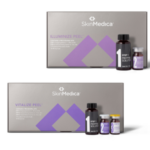Chemical peels are emerging as a favored choice among med spa treatments for those pursuing brighter, healthier skin. At Aluma Aesthetic Medicine, under the expert guidance of our master esthetician, Tatum, chemical peels stand out as a favored solution for dull skin and discolorations. In addition, chemical peels offer many benefits beyond surface-level concerns. “The exfoliative effect of chemical peels stimulates new epidermal growth and collagen with more evenly distributed melanin.” (1)
How Chemical Peels Work
Medical-grade chemical peels, often called corrective peels, involve applying various solutions to the skin’s surface at varying concentrations. These solutions containing alpha hydroxy acids, retinol, beta hydroxy acids, salicylic acid, and β-lipohydroxy acid induce a controlled epidermal injury, triggering the body’s natural wound-healing processes. The skin then undergoes a regeneration and remodeling phase, enhancing texture, strength, and appearance. (1)
The Process of Wound Healing
Wound healing encompasses several stages. First, hemostasis occurs. Blood vessels constrict to halt bleeding, and platelets aggregate at the wound site and release growth factors and cytokines. Then, inflammation begins, marked by the influx of immune cells that clear debris and prepare the groundwork for healing. Epithelialization follows as basal cells migrate to cover the wound, forming a protective barrier. Fibroplasia then kicks in, as fibroblasts produce collagen and granulation tissue, aiding in wound closure. Finally, maturation occurs, characterized by collagen remodeling, culminating in increased skin strength. (2, 3)
Types of Chemical Peels
Chemical peels come in various forms, each catering to specific skin concerns and depths. Light, superficial peels penetrate only the epidermis and can treat multiple conditions, including acne, melasma, photodamage, and scaly patches on the skin. Medium-depth peels target fine lines and mild scarring and address texture concerns. Deep peels are effective against deeper wrinkles and scars, reaching the bottom layer of the dermis, but cannot be used on everyone.
Our Favorite Light Chemical Peels

SkinMedica, renowned for its research-backed skincare solutions, offers a range of chemical peels designed to deliver exceptional results. With a legacy rooted in over 50 patents worldwide, SkinMedica’s Illuminize Peel and Revitalize Peel are premier light peels loved by many, and individuals with all skin types can use them. They excel at treating dull skin, discolorations, and acne. The main difference between the two is that the Revitalize Peel has retinol for increased cellular turnover, which helps those suffering from acne breakouts and more severe discolorations.
Are Chemical Peels Worth It
Yes! Chemical peels are an excellent option for rejuvenating dull skin and addressing various skin imperfections with no downtime. Aluma Aesthetic Medicine ensures that patients achieve radiant and revitalized skin by harnessing the principles of chemical peeling and tailoring treatments to individual needs. For those seeking a chemical peel in Portland, Oregon, Aluma Aesthetic Medicine is the destination for transformative skincare.
Citations:
1. Rendon, MD, a Diane S. Berson, MD, FAAD,b Joel L. Cohen, MD, FAAD,c Wendy E. Roberts, MD,d Isaac Starker, MD, FACS,e and Beatrice Wang, MD, FRCPC, FAADfEvidence and Considerations in the Application of Chemical Peels in Skin Disorders and Aesthetic Resurfacing J. Clin Aest Derm: 2010 Jul; 3(7): 32–43.
- Armstrong, David and Meyr, Andrew: Basic Principals of Wound Healing (lit. review article – Up-to-Date)
- Ross R, Everett NB, Tyler R. Wound healing and collagen formation. VI. The origin of the wound fibroblast studied in parabiosis. J Cell Biol 1970; 44:645.

